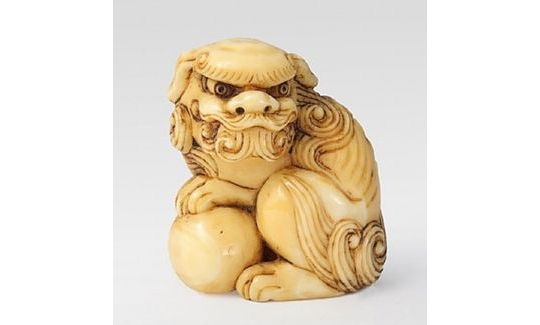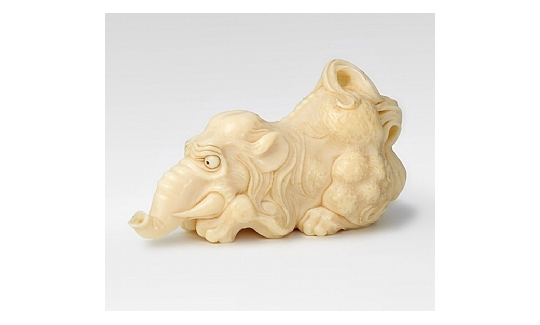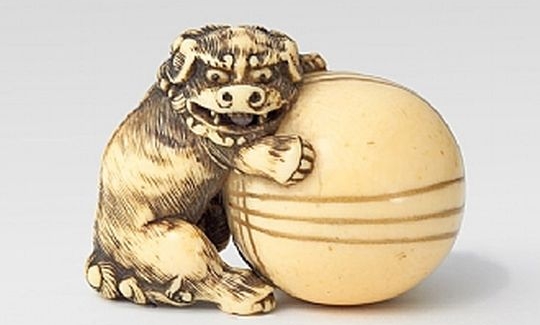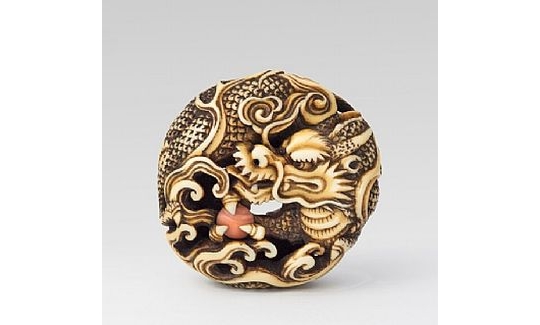The Lion-dog
The lion-dog (shishi or jishi) came to Japan with Buddhism, either from China or from Korea in the 7th or 8th century. The Japanese lion-dog has some elements of the koma-inu, the Korean dog, and of the kara-shishi, apparently derived from the Chinese foo dog.
There are no lions in Japan, China, or Korea. The first artworks depicting lions were brought to China in the Han era (ca. 208 BCE - 221 CE). The lion is regarded in China as the defender of justice and the guardian of sacred buildings, a symbol of power and success, nobility and strength. Its image is woven into the robes of the aristocracy. In Korea they believed that the skin of the koma-inu's head is stronger than any helmet. In Japan, the shishi is esteemed as a noble creature. A pair of lion-dogs usually guards the entrance to a Shinto or Buddhist temple, and Buddhist deities are often depicted riding on them. Sometimes a pair of lion-dogs is also placed beside a tomb.
In art, the shishi usually appear in pairs, male and female. In the Nara period (710-794) these were two lions. In the Heian era (794-1185) they began to appear as a lion and a lion-dog. In early Japanese depictions, the shishi has a horn on his head. The lion does not. The lion's maw gapes, that of the lion-dog is closed.
The open maw symbolizes the sound "ah", the first Sanskrit letter and the first letter in the Japanese kana script. The closed maw signifies the sound "n" - the last Sanskrit letter and the last kana letter. Together, they symbolize beginning and end, life and death, existence and all it contains. According to ancient Indian belief, the world was created with the first sound, and will be completed with the last. There are those who think that the open jaws are intended to drive away demons, and the closed mouth to shelter good spirits. In the Kamakura era (1185-1333) they stopped portraying the shishi with a horn, but the male is often depicted in art with his paw resting on a ball. This ball is a sacred Buddhist jewel (tama) representing the wisdom that illuminates the darkness of ignorance, and has the power to grant wishes.
In Japanese fables, the shishi is described as a playful creature. Female lion-dogs are depicted with their puppies, but even though they are known as protectors of children, there is a story about their custom of throwing the young shishi off a high cliff to test their courage and strength (saka otoshi shishi).
At the Japanese New Year they dance the shishi-mai, the lion-dog dance, during festivals and at the Shinto shrines. The dancers visit the local households in order to chase away evil spirits and diseases. They wear a shishi-gashira - a head covering shaped like a lion-dog. Wearing this mask they ‘bite' the family members, to ensure luck and good health.
The lion dance apparently reached Japan during or just before the
8th century, brought by envoys sent to China. The dance is also a kind of festival in Japan, a prayer for peace and plenty, a good harvest and good health. There are still about nine thousand different versions of the shishi-mai danced in the streets of Japan every year. According to tradition, a male shishi mask is placed by a newborn boy to protect him from evil spirits and misfortune, and there are still craftsmen producing such masks today. Some of them have horns, others look more like dogs or deer or lions.
In the collection of the Tikotin Museum there are many netsuke, sketches, and woodblock prints of lion-dogs. From the age of 82, the great artist Katsushika Hokusai (1760-1849) drew a shishi every morning, as an amulet to ward off evil spirits. Some of those drawings are presented in the exhibition.
Baku
The baku is a fabulous creature, having the head of an elephant with a short, powerful trunk, small ears like a cow, short fangs, and the mane and body of a lion. He has a cow's tail, and four claws on each foot. His hide is covered with large spots, and some representations show flames coming out of his body. In art, he is represented in netsuke figurines, and in carvings on the magnificent mausoleum of Shogun Tokugawa Ieyasu (1543-1616) at Nikko.
They say that Baku once used human speech. His outstanding virtue is that he devours our nightmares. When one has a bad dream, one must shout three times "Baku kurai!" ("Baku, eat it!") and he immediately comes to our aid. Until the end of the 19th century the Chinese ideogram for "baku" was still inscribed on headrests to ensure sound, dreamless sleep. This is why he is sometimes depicted in the netsuke playing with a headrest. At the beginning of the 20th century, headrests with such inscriptions had virtually disappeared, as had representations of Baku, who is also the god of the trees (Shirakina Kami). A picture bearing his name displayed at the entrance to a house serves as an amulet against disease. The baku who devours nightmares was also the inspiration for poems - like the following love-song:
"So short the night -
The baku does not even
have time to swallow dreams"
The Baku recently have appeared in Japanese anime (animation), manga (Japanese comics), and Playstation.
Kirin
The kirin (Chinese: ch'i-lin) is a legendary creature originating in China. He is one of four supernatural beings, and the ruler of three hundred other such creatures. The Chinese ideogram of his name implies that he is both male (ch'i) and female (lin). According to legend, Kirin was born of the union of two stars. Other versions suggest that he was the child of a dragon and a cow. The kirin has the head of a dragon or a horse, usually with a fleshy, pointed, backward-sloping horn. He has the body of a deer or a crocodile, the hindquarters of a lion, and a tail of either ox or a lion. His legs are those of a deer or a horse, and his feet are horses' hooves. Sometimes his body is covered with scales, but usually he is hairy. His skin is bluish or yellowish, and sometimes displays as many as five colours. Flames shoot out of his loins and his armpits.
The kirin embodies purity and modesty. He is gentle, noble, kind and conscientious. He treads lightly, soundlessly, leaving no footprints, harming no living thing. In Buddhism, he exemplifies perfection. According to Chinese belief there are sixteen types of kirin, each with his own name. In Japanese art, the kirin is mainly represented in the netsuke. A single kirin appears every thousand years, and his appearance is a good luck sign. Legends tell us that he appeared to the mother of Confucius, and to Confucius himself, who is depicted in works of art riding on a kirin.
Dragon
The dragon (ryu) reached Japan from China together with Buddhism. It has a camel's head, horns of a dear, eyes a hare, ears like a bull, neck of an iguana, scales of a carp, paws of a tiger, claws like an eagle. The ryu rules the clouds, the rain, and the water, and is one of the eight god-demons who protect Buddhism. These deities have wide mouths stretching from ear to ear, sharp fangs, horns, and all-seeing eyes.
In Japanese folklore there are many tales of dragons with supernatural powers. There is a story of a man who begged to accompany the poet Mukai Kyorai (1651-1704) on his travels in Kishu Province. In those days travelling was not easy. The man told the poet that he wanted to reach a specific coast. When they arrived, the man was so delighted that Kyorai asked him to explain his rejoicing. The man said he was a white snake, more than two hundred years old. The final task which the gods had given him was to reach that place, and now he could go to heaven and become a dragon. When he had finished speaking a great storm arose, and black clouds covered the sky. The man was transformed into a dragon, and was carried upward by the clouds and disappeared into the stormy sky.
There are many artistic representations of dragons rising heavenward, breathing out clouds, with gleaming eyes and slender moustaches hanging down on either side of their mouths, like those in the pictures of the ancient Chinese sages. In such pictures it is almost impossible to differentiate between dragons and clouds, they look like a single entity. The dragon associated with nature is perhaps a hint that whoseoever wishes to see a dragon has only to look carefully, because the dragon stands before him.
There is a very well-known story about a Shinto deity, Susanoo no Mikoto, who was banished from heaven to Izumo in western Japan. On the banks of the Hinogawa River he met an old couple who were weeping, and with them their daughter, lovely Kushinada. The old couple told him that they had had eight daughters, but each year the eight-headed dragon with eight tails (Yamata no Orochi) came and took one of them, and now they had only one left. The god offered to kill the dragon if they would let him marry their daughter as his reward. The old people agreed, and prepared eight barrels of rice wine, as the god requested. When the dragon appeared, the god made all its heads drink the wine, and it became drunk and fell asleep. Susanoo no Mikoto killed the dragon with his magic sword "The Sword of the Gathering Clouds" (Ame no Murakumo no Tsurugi), which he withdrew from his tail. Until this day, this sword is one of the three emblems of royalty in Japan. In the paintings the god can be seen waiting to catch the snake. The picture is sometimes known as "Susanoo no Mikoto kills the nine-headed dragon" (instead of eight heads and eight tails). The nine-headed dragon is one of the esoteric Buddhist deities. Some consider that the depiction of a Shinto deity killing a Buddhist deity symbolizes the victory of the original Japanese religion over the imported Buddhism.
There are four types of dragon: the heavenly dragon who guards the palace of the gods; the spiritual dragon who brings the rain; the earth dragon who creates the courses of the rivers; and the dragon guardian of earthly treasures. The Japanese dragon has three claws while the Imperial Chinese dragon has five. In many paintings the god Susanoo no Mikoto is shown with the dragon who rules the water, the ocean and the rain.





